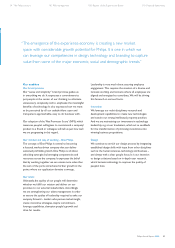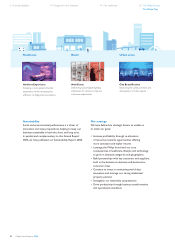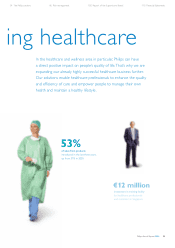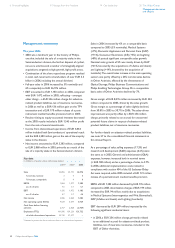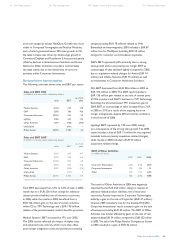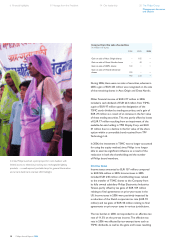Philips 2006 Annual Report Download - page 30
Download and view the complete annual report
Please find page 30 of the 2006 Philips annual report below. You can navigate through the pages in the report by either clicking on the pages listed below, or by using the keyword search tool below to find specific information within the annual report.
Philips Annual Report 200630
Management discussion and analysis
Forward-looking statements
This document contains certain forward-looking statements with
respect to the fi nancial condition, results of operations and business
of Philips and certain of the plans and objectives of Philips with respect
to these items, in particular the Outlook section of the chapter The
Philips Group in this Annual Report. By their nature, forward-looking
statements involve risk and uncertainty because they relate to events
and depend on circumstances that will occur in the future. There are
a number of factors that could cause actual results and developments
to differ materially from those projected or implied in these forward-
looking statements. These factors include, but are not limited to, levels
of consumer and business spending in major economies, changes in
consumer tastes and preferences, changes in law, the performance
of the fi nancial markets, pension costs, the levels of marketing and
promotional expenditures by Philips and its competitors, raw materials
and employee costs, changes in exchange and interest rates, changes in
tax rates and future business combinations, acquisitions or divestments
and the rate of technological changes, political and military developments
in countries where Philips operates, and industry consolidation.
Statements regarding market share, including those on Philips’
competitive position, contained in this document are based on
outside sources such as specialized research institutes, industry and
dealer panels in combination with management estimates. Where full-
year information regarding 2006 is not yet available to Philips, those
statements may also be based on estimates and projections prepared
by outside sources or management. Rankings are based on sales unless
otherwise stated.
Fair value information
In presenting the Philips Group’s fi nancial position, fair values are used
for the measurement of various items in accordance with the applicable
accounting standards. These fair values are based on market prices,
where available, and are obtained from sources that are deemed to be
reliable. Readers are cautioned that these values are subject to changes
over time and are only valid at the balance sheet date. When a readily
determinable market value does not exist, fair values are estimated
using valuation models, which we believe are appropriate for their
purpose. They require management to make signifi cant assumptions
with respect to future developments which are inherently uncertain
and may therefore deviate from actual developments. Critical
assumptions used are disclosed in the fi nancial statements. In certain
cases, independent valuations are obtained to support management’s
determination of fair values.
Non-US GAAP measures
Koninklijke Philips Electronics N.V. (the ‘Company’) believes that an
understanding of sales performance is enhanced when the effects
of currency movements and acquisitions and divestments (changes
in consolidation) are excluded. Accordingly, in addition to presenting
‘nominal growth’, ‘comparable growth’ is also provided. Comparable
sales exclude the effects of currency movements and changes in
consolidation. As indicated in the Accounting Policies, sales and
income are translated from foreign currencies into the Company’s
reporting currency, the euro, at the exchange rate on transaction
dates during the respective years. As a result of signifi cant currency
movements during the years presented, the effects of translating
foreign currency sales amounts into euros had a material impact
that has been excluded in arriving at the comparable sales in euros.
Currency effects have been calculated by translating previous years’
Philips Annual Report 200630
foreign currency sales amounts into euros at the following year’s
exchange rates in comparison with the sales in euros as historically
reported. Years under review were characterized by a number of
acquisitions and divestments, as a result of which activities were
consolidated or deconsolidated. The effect of consolidation changes
has also been excluded in arriving at the comparable sales. For the
purpose of calculating comparable sales growth, when a previously
consolidated entity is sold or contributed to a venture that is not
consolidated by the Company, relevant sales are excluded from
impacted prior-year periods. Similarly, when an entity is acquired,
relevant sales are excluded from impacted periods.
The Company uses the term earnings before interest, tax and
amortization (EBITA) to evaluate the performance of the Philips
Group and its operating divisions. Referencing EBITA will make
the underlying performance of our businesses more transparent by
factoring out the amortization of intangible assets, which arises when
acquisitions are consolidated. EBITA represents income from
continuing operations excluding results attributable to minority
interest holders, results relating to equity-accounted investees, income
taxes, fi nancial income and expenses, and amortization.
The Company believes that an understanding of the Philips Group’s
fi nancial condition is enhanced by the disclosure of net operating
capital (NOC), as this fi gure is used by Philips’ management to evaluate
the capital effi ciency of the Philips Group and its operating divisions.
NOC is defi ned as: total assets excluding assets from discontinued
operations less: (a) cash and cash equivalents, (b) deferred tax assets,
(c) other non-current fi nancial assets, (d) investments in equity-
accounted investees, and after deduction of: (e) provisions excluding
deferred tax liabilities, (f) accounts and notes payable, (g) accrued
liabilities, (h) current/non-current liabilities, and (i) trading securities.
The total net debt position as a percentage of the sum of total group
equity (stockholders’ equity and minority interests) and net debt is
presented to express the fi nancial strength of the Company. This
measure is widely used by investment analysts and is therefore
included in the disclosure.
Cash fl ows before fi nancing activities, being the sum total of net cash
from operating activities and net cash from investing activities, are
presented separately to facilitate the reader’s understanding of the
Company’s funding requirements.
A reconciliation of non-US GAAP information, as set out above,
to the most directly comparable US GAAP fi nancial measures is
given in the chapter Reconciliation of non-US GAAP information.
GAAP measures
The term earnings before interest and tax (EBIT) has the same
meaning as Income from operations (IFO), and is used to evaluate
the performance of the Philips Group and its operating divisions.
The term ‘equity-accounted investees’ was previously referred to
as ‘unconsolidated companies’; the meaning however is the same.
Reclassifi cation
Philips completed the sale of a majority stake in its Semiconductors
division on September 29, 2006. Previous years have been restated
to present the Semiconductors division as a discontinued operation.
6 Financial highlights 8 Message from the President 14 Our leadership 20 The Philips Group
Management discussion
and analysis
The following discussion is based on the US GAAP consolidated fi nancial
statements and should be read in
conjunction with these statements. The section which analyzes the 2005 fi nancial results compared to 2004,
and the section critical accounting policies, have not been included in this Annual Report. These sections are
included in Philips’ Form 20-F for the fi nancial year 2006, which is fi led electronically with the US Securities
and Exchange Commission.



